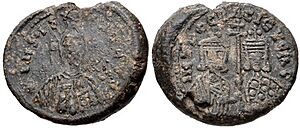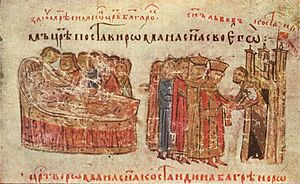Peter I of Bulgaria facts for kids
Quick facts for kids Peter IПетър І |
|
|---|---|
| Tsar of Bulgaria | |

Seal of Emperor Peter I with Irene Lekapene
|
|
| Reign | 927–969 |
| Predecessor | Simeon I |
| Successor | Boris II |
| Died | 30 January 970 |
| Spouse | Irene Lekapene |
| Issue | Boris II Roman |
| House | Krum's dynasty |
| Father | Simeon I |
| Mother | George Sursuvul' sister |
Peter I (Church Slavonic: Петръ А҃; Bulgarian: Петър I) was the emperor, or tsar, of Bulgaria from 927 to 969. His rule lasted a long time, about 42 years. Early in his reign, Peter faced some tough challenges. These included a religious movement called the Bogomil heresy and even rebellions from his own brothers. He also had to deal with a Serbian prince named Časlav Klonimirović.
However, Peter found more success later on. He managed to make the invading Rus army leave Bulgaria. He did this by getting Bulgaria's allies, the Pechenegs, to attack the Rus capital, Kiev. For a long time, people thought Peter was a weak ruler who lost land and power. But new studies show that Bulgaria was actually rich and peaceful during his time. People in the Middle Ages thought he was a good ruler. Later leaders who wanted to bring back Bulgarian independence used his name to show they were rightful rulers.
Contents
Becoming Emperor: Peter's Early Rule
Peter I was the son of Simeon I of Bulgaria, who was a powerful emperor. Peter's mother was the sister of a man named George Sursuvul. Peter was born in the early 900s. It seems his uncle, George Sursuvul, had a lot of influence when Peter first became emperor.
In 913, Peter might have visited the emperor's palace in Constantinople with his older brother, Michael. For reasons we don't know, Simeon made Michael become a monk. This meant Peter was chosen to be the next emperor.
Making Peace with Byzantium
To show he was a strong leader, Peter started his rule with a military attack. He moved into a part of the Byzantine Empire called Byzantine Thrace in 927. This was the last battle of a long war between Bulgaria and Byzantium. But after these quick wins, Peter secretly started talking about peace. The Byzantine Emperor, Romanos I Lakapenos, was happy to agree.
They arranged a special marriage between Peter and the emperor's granddaughter, Maria. In October 927, Peter went to Constantinople to meet Romanos. They signed a peace treaty, and Peter married Maria on November 8. To show the new peace between Bulgaria and Byzantium, Maria was renamed Eirene, which means "peace." The famous Preslav Treasure might have been part of Maria's wedding gifts. This peace treaty was a big success for Bulgaria. It brought back the borders that were set in earlier agreements. The Byzantines also recognized Peter's title as emperor (tsar). They also agreed that the Bulgarian Church could be independent. Plus, the Byzantine Empire agreed to pay Bulgaria money every year.
Challenges and Changes During Peter's Reign
Even though Peter had a good start, he faced some problems. Around 930, his younger brother Ivan started a rebellion. Ivan was defeated and sent away to the Byzantine Empire. Soon after, Peter's older brother Michael escaped from his monastery. He led a bigger rebellion, but he died soon after. Peter's youngest brother, Benjamin, was accused of being a magician by an Italian bishop. But Benjamin didn't seem to cause any trouble for Peter's rule.
Serbia Regains Independence
Around this time, the Prince of Serbia, Časlav Klonimirović, escaped from the Bulgarian capital, Veliki Preslav. With some quiet help from the Byzantines, he started a Serbian revolt against Bulgarian rule. This revolt worked, and Serbia became independent again.
Dealing with the Magyars
Peter also had to deal with the Magyars. These were a group of people who had been defeated by his father in 896. They had settled in a region called Pannonia. Peter might have lost a battle to them at first. But then he made a deal with them. He started using Magyar groups as allies against Serbia. Some Magyar groups even began to settle in Bulgarian lands north of the Danube River. They might have become allies of Bulgaria, meaning they were independent but helped Bulgaria. This eventually led to Bulgaria losing that land to the Magyars much later. Peter also seemed to let these Magyar groups cross Bulgaria to raid Byzantine lands. This might have been a way to get back at the Byzantines for helping the Serbian rebellion.
Life in Bulgaria Under Peter I
Peter I ruled for a long time, and it was mostly a peaceful period. We don't have many detailed writings about this time. But it seems that Bulgaria was rich and well-organized. Foreign travelers noticed its good government. Many imperial seals found from this time also show how well-run the country was.
Peter was very generous to the Church. He gave a lot of money and gifts to churches throughout his rule. Some religious leaders, like Cosmas Presbyter, even thought he was too generous. Other people chose to live a simple, religious life away from society. One famous example is Saint Ivan of Rila. Even so, Peter paid attention to these holy people.
The wealth and social differences might have helped the Bogomil religious movement spread. This was a new belief that Peter tried to stop. He asked for advice from famous holy men and even his uncle-in-law, Patriarch Theophylact of Constantinople.
Later Conflicts with Byzantium and Rus
Relations with the Byzantine Empire got worse after Peter's wife died in the mid-960s. The Byzantine Emperor, Nikephoros II Phokas, had won battles against the Arabs. In 966, he refused to pay the yearly money to Bulgaria. He complained that Bulgaria was allied with the Magyars. Nikephoros II then showed his military strength at the Bulgarian border.
Instead of attacking Bulgaria directly, Nikephoros II sent a message to the Rus prince Sviatoslav Igorevich. He asked Sviatoslav to attack Bulgaria from the north.
Sviatoslav quickly launched a huge attack with 60,000 soldiers. They defeated the Bulgarians near the Danube River and in a battle near Silistra. They captured about 80 Bulgarian fortresses in 968. Emperor Nikephoros II was surprised by Sviatoslav's success. He also started to worry about Sviatoslav's real plans. So, Nikephoros II quickly made peace with Bulgaria. He arranged for his young relatives, the emperors Basil II and Constantine VIII, to marry two Bulgarian princesses. Two of Peter's sons were sent to Constantinople as negotiators and special guests.
Meanwhile, Peter managed to make the Rus forces leave. He encouraged Bulgaria's old allies, the Pechenegs, to attack Kiev, the Rus capital.
Despite this temporary success and the peace with Byzantium, Bulgaria faced another invasion from Sviatoslav in 969. The Bulgarians were defeated again. Peter then suffered a stroke. This led him to give up his throne and become a monk. He died on January 30, 970.
Peter's Legacy: How He is Remembered
Compared to his father's military victories, Peter was often seen as a weak ruler. People thought he lost land and power. They believed his army got weaker, and foreign invaders attacked his country. Some even thought Bulgaria became like a puppet state of Byzantium.
However, newer studies challenge this idea. They highlight how rich and peaceful Bulgarian society was during his long rule. They also look differently at Bulgaria's relationship with its neighbors, the Magyars and Pechenegs. They also question if the Byzantine princess, Peter's wife, really had a bad influence. While the Bogomil religious movement spread during Peter's reign, it might have started for other reasons. The Bulgarian Orthodox Church even made Peter a saint.
Peter was considered a good ruler in the Middle Ages. When Bulgaria later fell under Byzantine rule (from 1018 to 1185), other leaders tried to bring back Bulgarian independence. They used Peter's name, like Peter Delyan and Constantine Bodin. This was to show that they were the rightful rulers and continued Peter's legacy.
Peter's Family
Peter I and his wife, Maria Lakapena (who was renamed Eirene), had several children, including:
- Plenimir
- Boris II, who became emperor of Bulgaria in 969
- Roman, who became emperor of Bulgaria in 977


